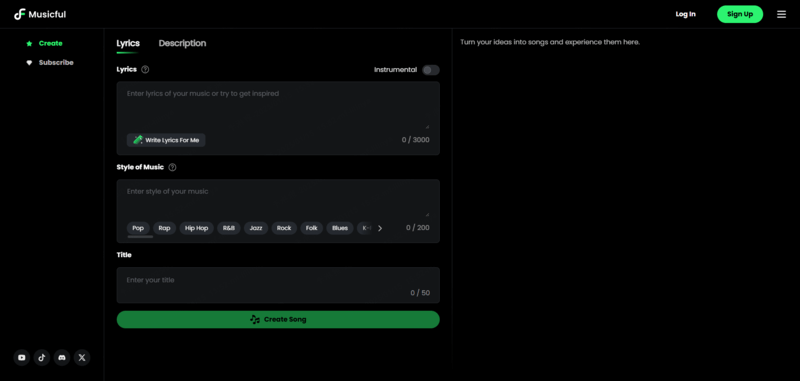Mar 18, 2025
4 min read
Suno AI can turn text into full songs, covering different genres, moods, and styles, but you need well-crafted prompts to match your idea.

This guide will show you how to write effective Suno AI prompts, starting with the basics and progressing to advanced techniques.
We also introduce a Suno AI alternative that can create more detailed, expressive, and unique music.
- 1. Common Mistakes to Avoid When Prompting Suno AI
- 2. Popular Music Prompts for Suno
- 3. Suno Prompts Examples
 Part 5:FAQ about Suno AI Prompts
Part 5:FAQ about Suno AI Prompts
Part 1:What is Suno AI Prompts?
A Suno AI prompt is a set of instructions or keywords that guide the AI in making music. It tells Suno AI what kind of song you want, the mood you’re aiming for, and the instruments you’d like to hear. Think of it as giving directions to a skilled musical partner who turns words into tracks.
A well-structured prompt acts like a roadmap, leading Suno AI to create music that fits your idea. If you want more control, Suno AI offers a "Custom Mode." This lets you fine-tune lyrics and musical style for a more personal touch.
Part 2:What is Components of Suno Prompts?
To create great music with Suno AI, it's important to understand the key parts of a good prompt.
Genre/Style:The musical category or type of music. This sets the overall feel of the song. Whether it's pop, rock, jazz, or electronic, picking a genre helps Suno AI understand your musical direction.
Mood/Emotion:The feeling or atmosphere the music should evoke. Words like "happy," "melancholic," or "energetic" guide the AI in setting the right tone.
Instrumentation:Mentioning key instruments helps to shape the sonic palette of the generated music.You can specify instruments like piano, electric guitar, or orchestral strings to refine the sound.
Tempo/Rhythm:The speed and rhythmic feel of the music.You can use terms like "fast-paced" or even a specific BPM.
Vocal Preferences:Characteristics of the vocals, such as tone and singer type.
Structure tags:The organization of different musical sections. Such as [Intro] or [Chorus]....,etc.
Part 3:How to Craft Effective Suno Prompts?

1. Common Mistakes to Avoid When Prompting Suno AI
Being too vague - Generic prompts lead to uninspired music. Instead of "happy song", try "upbeat pop with catchy melodies".
Overloading with details - Too much information can confuse the AI. Keep the prompts clear and focused.
Ignoring key elements - Specify tempo, mood and instruments for better results.
Not refining prompts - Adjust and experiment rather than expecting perfection on the first try.
Using overly complex terms - Keep descriptions simple and clear.
Neglecting meta tags - Use tags like "[verse]" and "[chorus]" for structured songs.
2. Popular Music Prompts for Suno
Genre-Specific Suno Prompts
Guide Suno to focus on particular music genres.
-
"Compose a soothing lo-fi track for studying."
-
"Generate a retro 80s synthwave instrumental."
Mood-Focused Suno Prompts
Direct the AI to produce music that evokes a specific feeling.
-
"Create a sad song."
-
"Produce an uplifting orchestral piece for a motivational video."
Instrument-Based Suno Prompts
Highlight specific instruments for unique compositions.
-
"Compose a piece of jazz music led by a saxophone."
-
"Focus on acoustic guitar for a soulful folk melody."
Experimental Suno Prompts
Encourage Suno to combine styles or experiment with sounds.
-
"Blend elements of classical music with modern trap beats."
-
"Create an ambient track inspired by futuristic sci-fi themes."
3. Suno Prompts Examples
Simple Suno Prompts for Beginners
-
"Make a happy pop tune with catchy lyrics."
-
"Generate a relaxing background track with soft piano and chords."
Advanced Suno Prompts for Experienced Users
-
"Produce a cinematic score with dramatic crescendos and a choir."
-
"Compose a progressive rock piece with dynamic tempo changes."
Community-Inspired Suno Prompts
-
"Write a playful melody inspired by classic video game soundtracks."
-
"Create an atmospheric track for meditation and mindfulness."
With these examples, you can experiment and refine your own Suno prompts to achieve stunning results!
Part 4:Discover a Great Suno AI Alternative
While Suno AI is a powerful tool for music generation, exploring Suno alternatives can expand your creative potential. One standout option is Musicful, a versatile AI-powered platform designed to bring your musical ideas to life effortlessly.

Best Prompts for Music Generator AI
Part 5:FAQ about Suno AI Prompts
1. How to write good prompts for Suno AI?
To write effective Suno prompts, be specific and clear about your expectations.
-
Include genre: "Create a calming lo-fi track."
-
Define the mood: "Compose an uplifting orchestral piece."
-
Specify instruments: "Focus on acoustic guitar with subtle drums." Good prompts combine these elements to give the AI precise instructions.
2. What are good AI prompts?
Good AI prompts are:
-
Concise: Avoid long, overly detailed instructions.
-
Specific: Clearly mention style, instruments, or emotion.
-
Action-Oriented: Use verbs like compose, generate, or create.
Examples:
-
"Generate a suspenseful track with deep bass."
-
"Compose an upbeat acoustic folk melody with a lively tempo."
3. How to get the best results with Suno?
-
Experiment and Iterate: Start with simple prompts and gradually add details to refine the output.
-
Use Examples: Reference a song or style for the AI to emulate.
-
Leverage Community Ideas: Check platforms like Reddit for tried-and-tested prompts shared by other users.
Conclusion
Suno AI is changing how music is made, making it easier and more creative for all musicians. Through the simple music prompts for Suno, you can make amazing music. Try Suno prompts today and see what you can create!
You can also try Musicful , which not only generates AI music, but also allows you to do similar music finding and audio/video conversion for free, bringing you more inspiration!


